by Marcela M. | Oct 16, 2011 | Blog, Recipes, Uncategorized
Good morning dear friends! I hope you are having a lovely weekend.
A few months ago, while browsing the internet, I stumbled upon a series of truly beautiful and very creative videos on vimeo. Among these, there were the followingones, which I believe take recipe sharing to a whole new level: they transform it into a piece of art.
I hope you will like them as much as I do!
NOTE: Since embedding is not working, I am linking to the videos instead. Sorry for the inconvenience!
Beet cake, by Tiger in a Jar:
The apple galette, by rachelchew
Avocado, Shrimp and endive salad, by Leaftv
Plum Jam, by Carl Pendle
Have a wonderful week!
by Marcela M. | Oct 10, 2011 | Blog, Pies, Recipe Box, Recipes, Sweets, Uncategorized
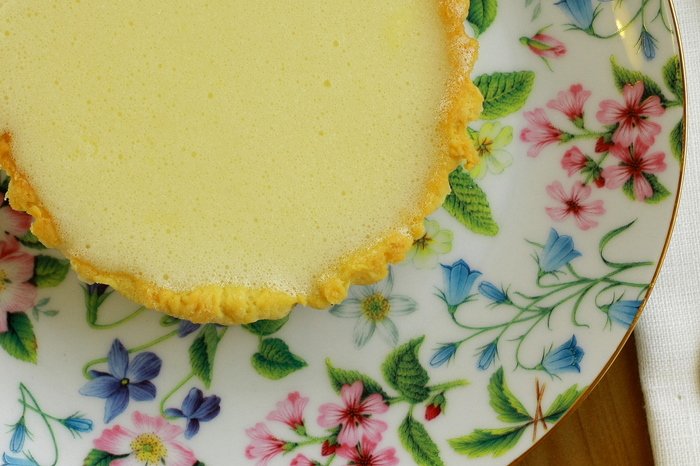
Good morning dear friends!
How are you today? How did you start this week? I hope you are all well and happy.
The weather in Nicosia is barely starting to get colder, so my recipes are still in a very summery mood. The one I bring you today was born from an experiment: I was going to meet some friends for tea, and wanted to bring something sweet for the occasion.
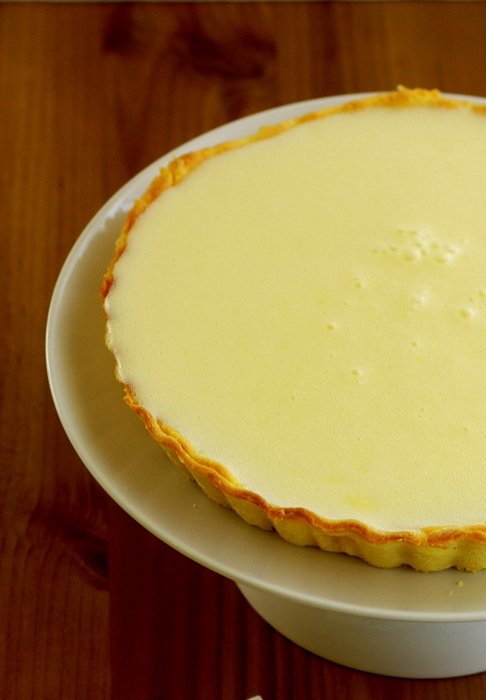
When I was wondering what recipe I could make, I recalled that I had Lemon Coconut Mousse leftovers in the freezer, and I thought I could use them to make a Lemon (coconut) mousse pie.
Since the mousse is very sweet and flavourful, I decided to bake a neutral crust that wouldn’t overpower the filling. The crust I made is the one I generally make with the traditional Lemon Meringue pie (crust, filled with lemon curd, topped with meringue), and which always turns out perfect. It is also a crust that is very easy to adapt: my basic chocolate crust is based on this one, for example.
So, first, I prepared the crust, baked it and let it cool completely. Then, I adapted the mousse. In order to firm it up and transform it into a proper pie filling, I added one envelope (30 grs) of clear, unflavoured gelatin dissolved in warm water to it (after defrosting), I mixed everything well, and I poured it on top of the baked crust.
Finally, I put the pie in the fridge for 3 hours, and it was ready!
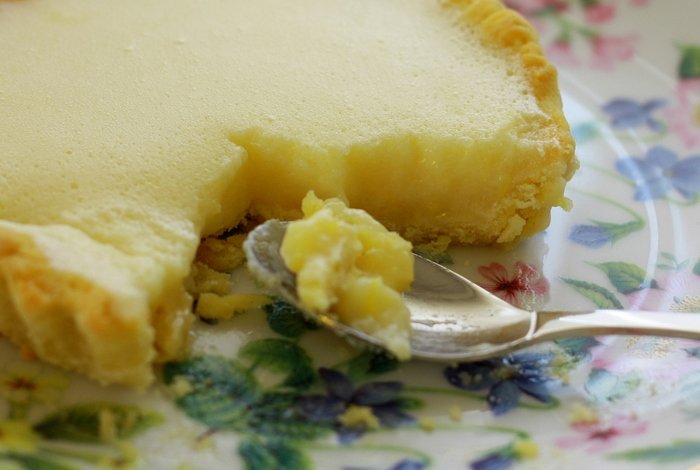
Here is the recipe:
1) Make the crust: Mix 200 grs flour, 100 grs butter and 2 spoons sugar, until you get a sand-like consistency. Add 1 egg and 1 egg yolk and incorporate them well into the dry ingredients, until you get a workable dough. Make a ball with it, cover it in foil and let in rest in the fridge for 15 minutes. After that, remove it from the fridge, extend it with a rolling pin and cover a 9- inch pie pan. Pinch the base of the crust with a fork in several places so that it doesn’t grow in the oven. Bake at 175C for 10/15 minutes, or until it becomes slightly golden in colour and separates from the pan. Remove from the oven and let it cool down completely.
2) Make the filling: Make the Lemon Coconut Mousse according to the instructions given HERE. Add 1 envelope of unflavoured gelatin, dissolved in 1/4 cup of warm water and 1/4 cup cold water, or as per product’s instructions. Mix well.
3) Assemble the pie: Pour the filling into the the baked crust. Put in the fridge for 3/4 hours
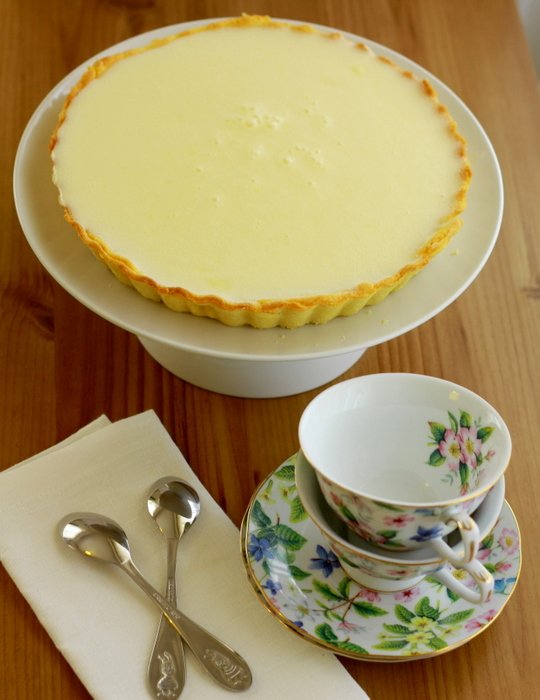
Optional: I like the pie just as it is, but you could also give it a different finish, such as the following:
a) Cover it in meringue,
b) Pipe whipped cream on top, and then sprinkle some lemon zest over it.
c) Top it with whipped coconut cream, and sprinkle shredded coconut, lemon zest or a combination of both over it.
I hope that you like it!
Have a wonderful week!
by Marcela M. | Oct 3, 2011 | Blog, Drinks, Recipe Box, Recipes, Uncategorized
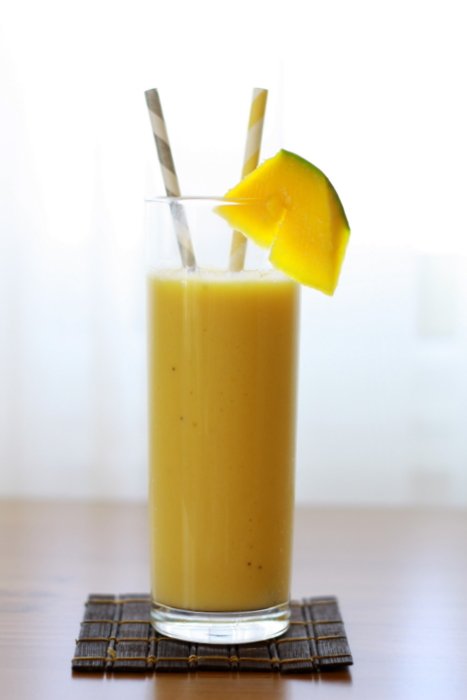
Good morning dear friends! I hope you had a lovely weekend.
As I mentioned two posts ago, I recently found tropical fruits in my local supermarket, and they brought memories of days past, memories of Ivory Coast. So I bought mangos, papayas, bananas…a bit too many of them, to be honest. At first, I ate them raw, and after a few days (when we got tired!) I started thinking about what to do with them.

I then recalled a simple fruit salad that I used to eat back in Abidjan and which consisted in dices of mango, papaya and banana, tossed together with a teaspoon of honey (I like acacia) dissolved in a the juice of half a lime (to kill the sweetness) and sprinkled with a few almonds on top. Simple and nice.
So I ate my fruit salad, and I was considering what to do with the remaining fruits when I thought that I could use the same ingredients in a different way. The weather is still warm in Nicosia, and we are still wearing our summer clothes, but we also know that it won’t last much longer, so I thought that this was my last chance of making a summery smoothie until next year.
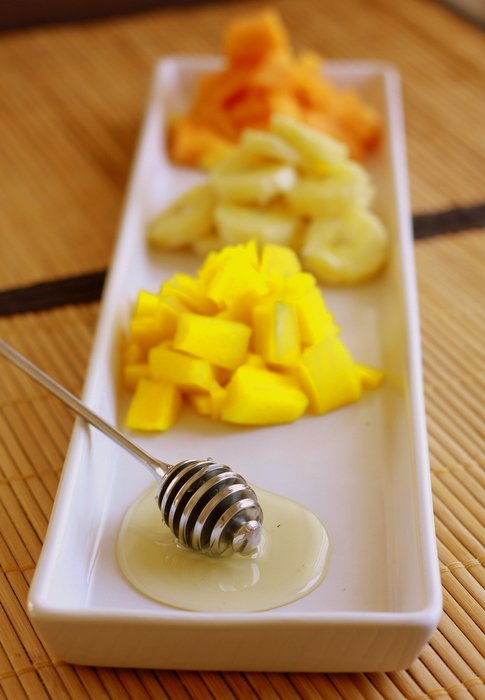
So a tropical fruits smoothie I made!
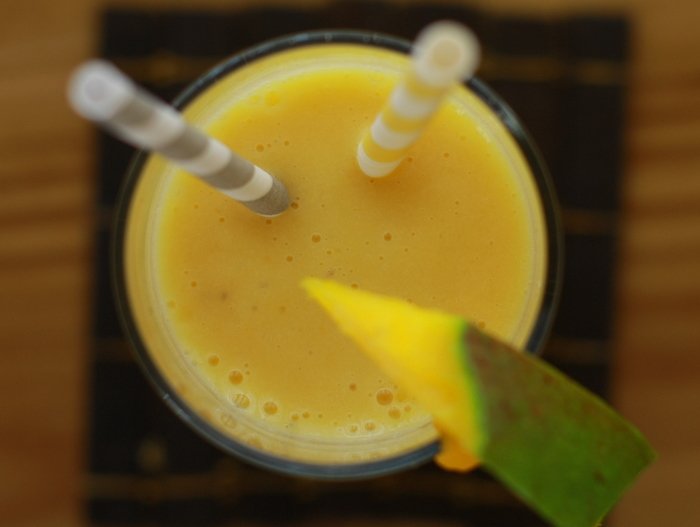
I chopped 1 mango, 1 papaya and 1 ripe banana, and I put them in the blender together with 1/2 cup of crushed ice, 2 teaspoons of acacia honey and 2 glasses of almond milk (if they don’t sell almond milk where you live,you can make your own following this recipe and instructions). I blended it all for a few minutes, until there were no more visible fruit chunks, and then I served it with a couple of straws (to make it more appealing to my children!)
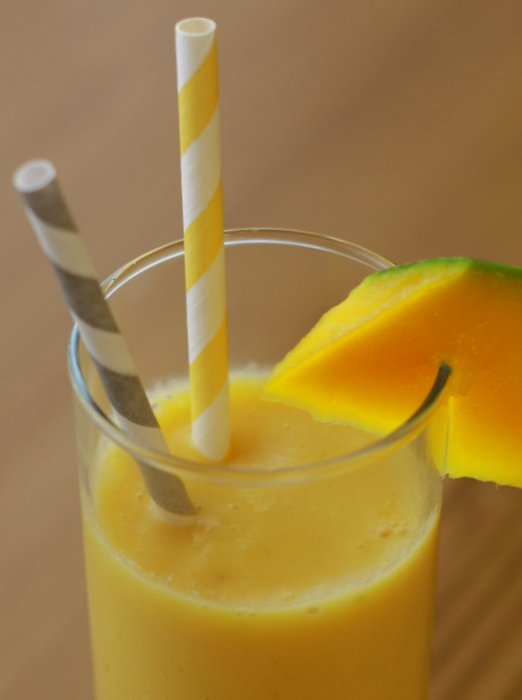
It was a perfect way to say goodbye to the long days of summer, and to welcome autumn- even though there is still no sign of it.
Now may I ask something from you? My Owl cupcakes are competing in Sweetopia‘s Sweet of the week contest. Would you be so kind to vote for me, pleeeease? 🙂 Thank you! There are some really pretty confections competing this week so I’m sure you will enjoy taking a look at all entries.
Have a wonderful week!
by Marcela M. | Sep 26, 2011 | Blog, Recipes, Uncategorized
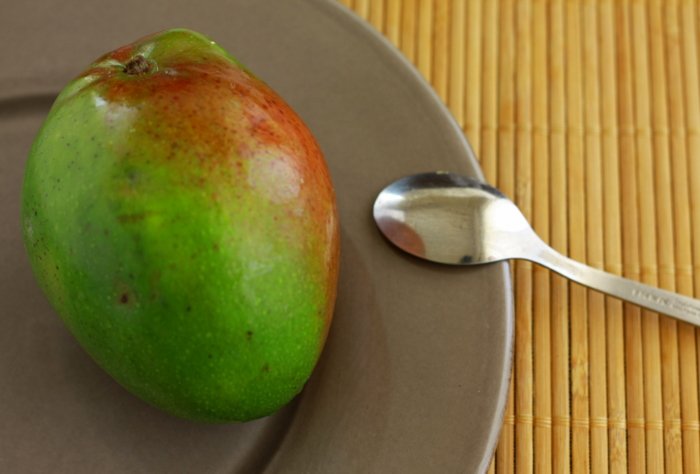
Good morning friends! I hope you are having a lovely start of the week!
In my last post, I mentioned that one of the things I learnt in Ivory Coast was how to dice a mango.
If, like me, you didn’t grow up in a country where tropical fruits are the norm, you may do as I did originally: try to peel the mango as if it was an apple, slice it and finally dice it. The problem is this: mango skin is not apple skin. It is much harder to remove! Fortunately for me, the man I used to buy my groceries from taught me the easy way of doing it, which is what I will share with you today.
1) The first thing you will need to do is to slice the mango. Yes, with the skin still on. Trust me.
2) Once you have done this, cut the flesh into squares, being careful not to cut the skin. You want to flesh to remain attached to the skin until the last step or it will take you ages to finish. It has to look like this:
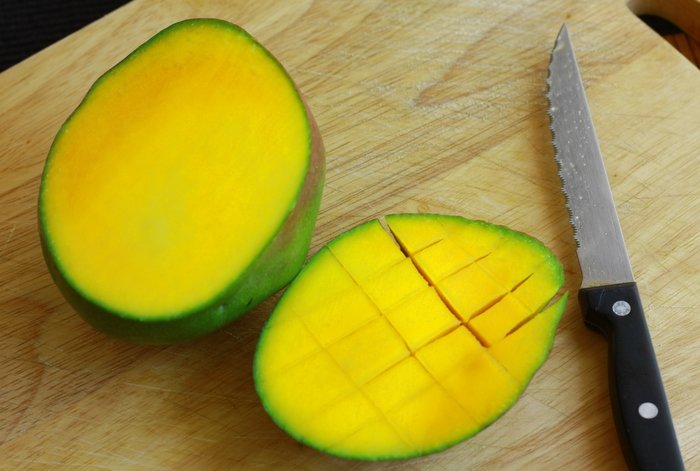
3) Take the mango’s sides with your hands and curve the mango slice, making the squares pop, like this:
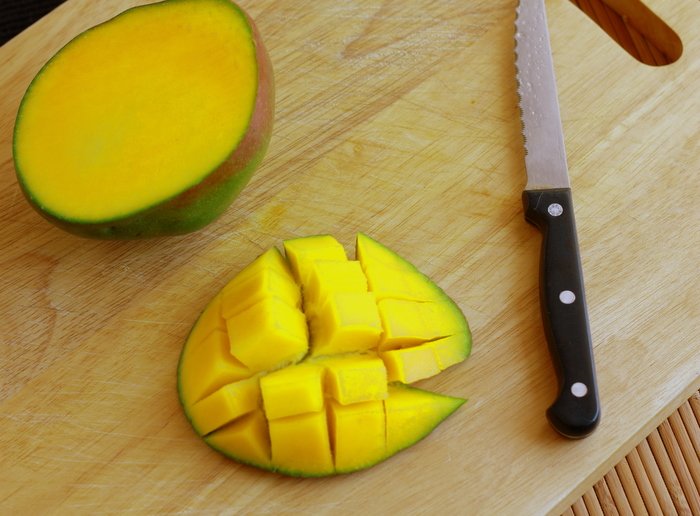
4) Finally, run the knife between skin and flesh. The mango squares will come out very easily!
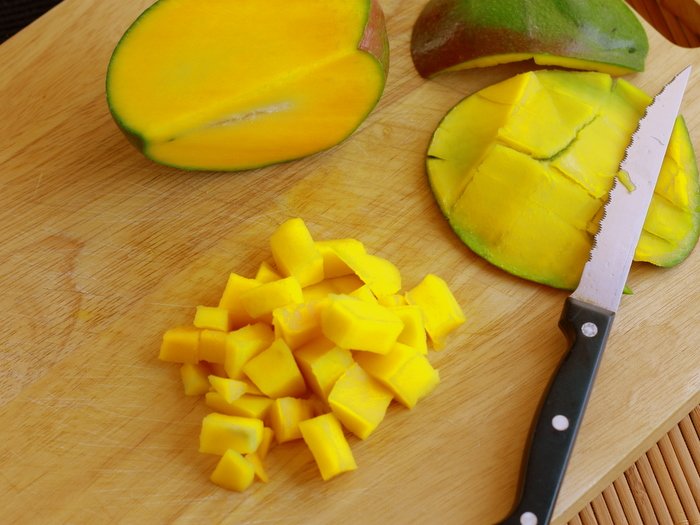
Now grab the spoon that silly-me placed in the first picture (wrong prop! what was I thinking?!) and eat your yummy mango squares!
Have a wonderful week!
by Marcela M. | Sep 19, 2011 | Africa, Blog, Recipes, Travel, Uncategorized
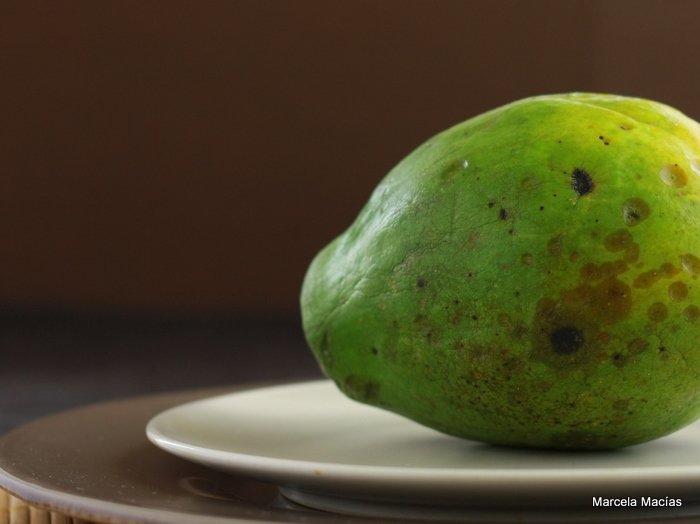
Good morning dear friends! I hope you are having a lovely Monday. I apologize for not posting regularly, I am currently studying for an exam and I can’t seem to find the time to post as regularly as I would like to.
Last week, during our weekly grocery shopping, I spotted a few tropical fruits at our local supermarket. Even though they were imported from Brazil (a country that I have been fortunate to visit in a few occasions), they reminded me of Ivory Coast, where I lived from 2005 to the end of 2007, and where I met my husband.
Tropical fruits were abundant and, since they were locally grown, they were very cheap too. There were different kinds of papayas (small, ball sized ones, and also big ones, the size of a watermelon) , different kinds of bananas (tiny ones, big ones called “banane plantain” – with which alloko was made, and regular- sized ones), pineapples (the ones from Assinie Maffia, were tiny and especially sweet) and mangoes, among many others.
Mangoes, especially the ones from the northern state of Korhogo, were so delicious, so incredibly sweet that if you ever find them wherever you live, I encourage you to buy one for tasting purposes at least. Other fruits, such as apples and pears were also available in big cities, such as Abidjan, especially in big supermarkets, but were much more expensive. Local fruits could be bought at the local markets, where the grocer would also advice us on how to distinguish the good fruits, how to cut them, how it was best to cook them. It was there that I learnt how to dice a mango, how to chose the best avocado, and how to select a ripe pineapple.
During the two and a half years that I spent in Ivory Coast, I lived in two different cities (Daoukro and Abidjan), and travelled to many others. When I was deciding what to do with the fruits I had bought the other day, it was Abidjan that I remembered.
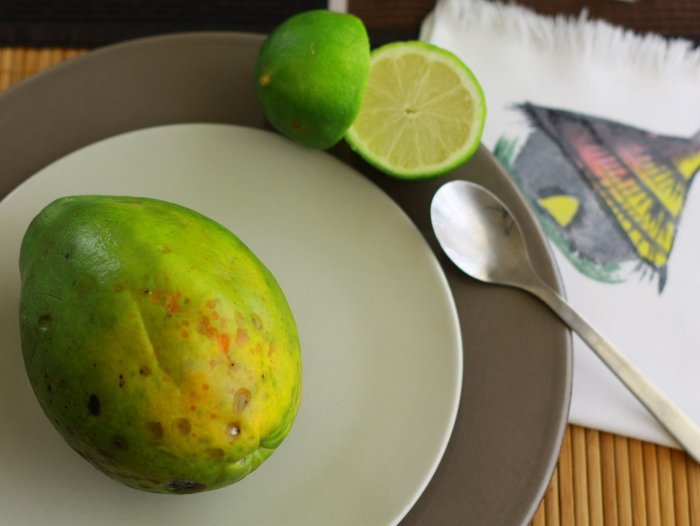
When we lived there, we used to go to a bar/restaurant called Jardiland, a beautiful place with tables in the garden, amid the luscious vegetation, Moroccan lamps hanging from the ceiling, soft music, candle-lit tables and with two cute bambies walking around the greenery and greeting guests while they ate. It was a lovely place to spend a quiet evening.
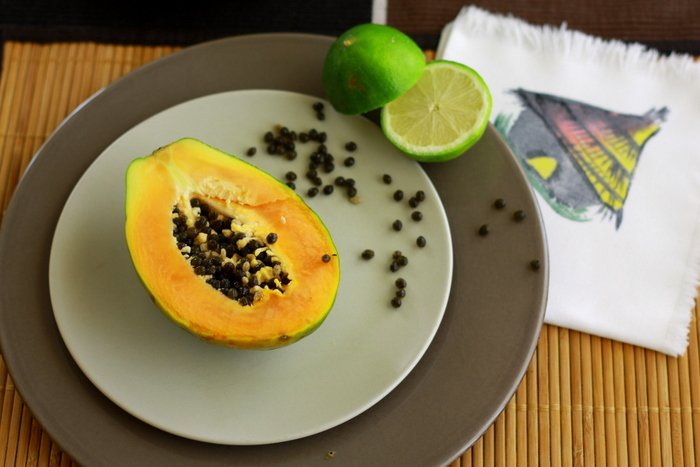
Jardiland had a tradition I liked (if I can call it that way): whenever the food was taking too long, they would serve the customer a papaya, sliced in half, accompanied by half a lime, to sprinkle its juice over it. The bitterness of the lime complemented wonderfully the sweetness of the papaya. It was a simple, yet delicious way of waiting for the tasty food to come.
So, in honour of the end of summer, of Ivory Coast and the time we spent there, I decided to eat one of the papayas just like that, with a little bit of lime juice sprinkled over it. There is great beauty in simplicity too, great dishes do not need to be complicated.
Have you ever had tropical fruits? Do you like them? What is your favourite simple dish?
Have a wonderful week!
by Marcela M. | Sep 8, 2011 | Blog, Main courses, Recipe Box, Recipes, Savories, Uncategorized
Hello dear friends! I hope you are having a lovely week
Today I have a BIG surprise, one that I have been dying to tell you about: Two of my recipes, with their pictures, are featured in the September issue of Whole Kitchen Magazine!!!
Last July, I was contacted by Silvia (who writes the beautiful blog Food and Cook, for Elle Magazine). Silvia is also one of the editors of Whole Kitchen and, to my surprise and utter delight, she asked me to collaborate with their September issue. I immediately said YES, of course! Whole Kitchen is a beautiful magazine, full of delicious recipes and gorgeous photography, edited by bloggers I have been following for a long time, and with amazing contributors, so it is a real honour to be able to be a part of it.
In this issue you will find one savory recipe from me: cheese and echalottes tartelettes, with a hint of cumin (pages 58-61)…
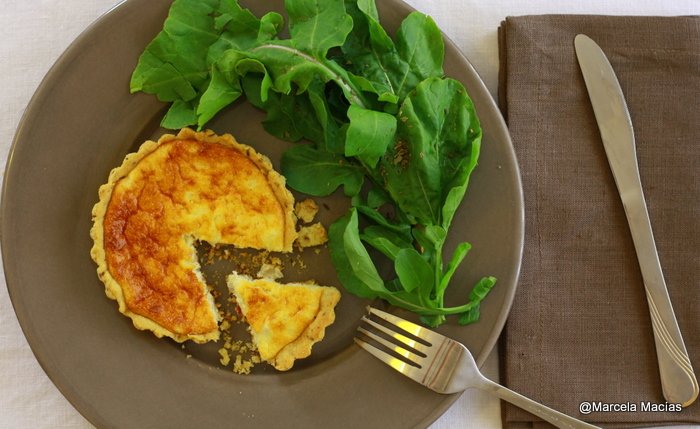
…And one dessert: Chocolate and pear mousse pie (pages 98-101)
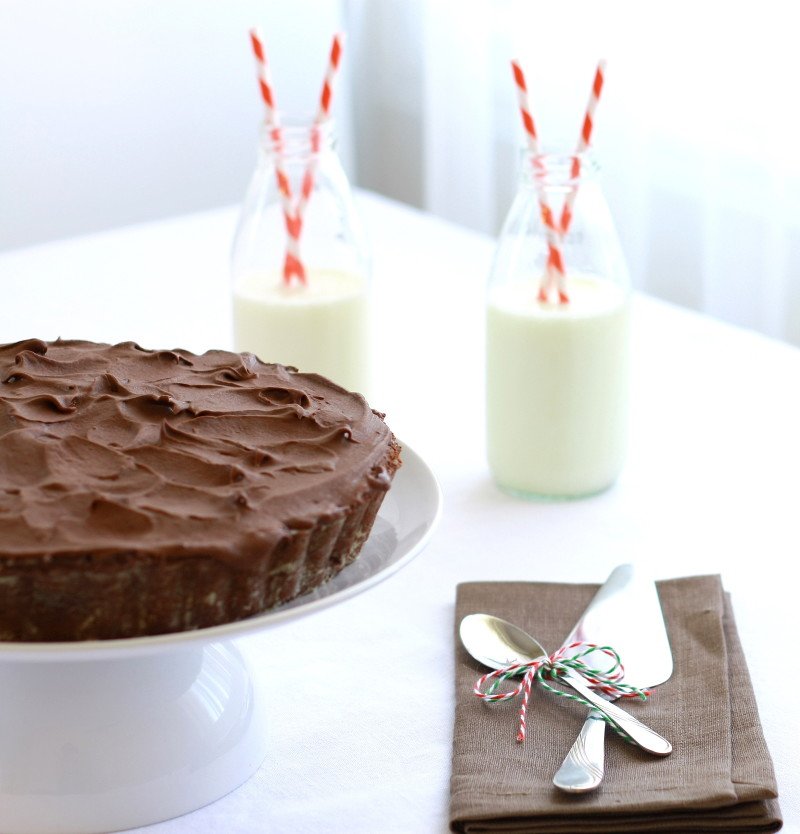
This issue also includes great lunch-box ideas, as well as cookies, muffins and pies which could be prepared with children.It has also added a new section called ” Living”, with articles on fashion, beauty and wellness.
Silvia and Beatriz: thank you so much for letting me be a part of your beautiful magazine!
May you all have a wonderful weekend!
NOTE: For the recipe of Chocolate and Pear Mousse pie in English, click here.


















